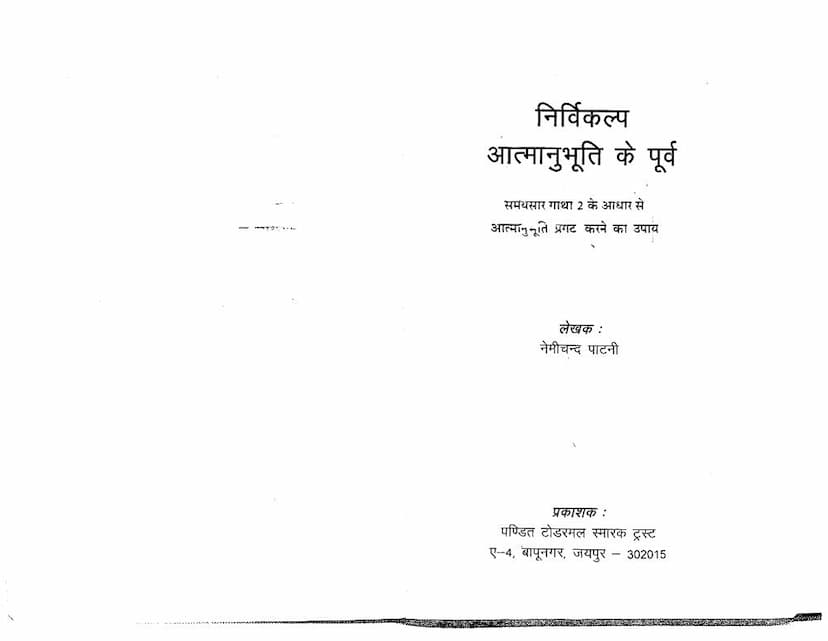Nirvikalp Atmanubhuti Ke Purv
Added to library: September 2, 2025

Summary
Here's a comprehensive summary of the Jain text "Nirvikalp Atmanubhuti ke Purv" by Nemichand Patni, based on the provided pages:
Book Title: Nirvikalp Atmanubhuti ke Purv (Before Undifferentiated Soul-Experience) Author: Nemichand Patni Publisher: Todarmal Granthamala Jaipur
Core Subject: The book, written based on the Samaysar scripture (specifically Gatha 2), outlines the path and inner transformation required for an aspirant to achieve Nirvikalp Atmanubhuti (Undifferentiated Soul-Experience), which is considered the gateway to Sammyagdarshan (Right Faith) and ultimately, the path to liberation (moksha).
Key Themes and Concepts:
-
The Importance of True Understanding: The text emphasizes that true realization (Anubhuti) comes only through proper understanding. Superficial knowledge or rote learning is insufficient.
-
The Goal of Moksha: The ultimate aim is liberation from the cycle of birth and death, achieved through the cessation of suffering.
-
The Core of Jain Philosophy: The book stresses that the essence of all Jain scriptures (Dwadasanga) points towards achieving Vitraagta (passionlessness) and realizing the true nature of the soul.
-
The Soul's True Nature (Dravya Swabhav): The soul is identified as the eternal, unchanging, pure conscious principle (Trayakall Gyayak Dhruv). This is the ultimate reality, distinct from all transient states and external substances.
-
The Role of Right Faith (Sammyagdarshan): This is the foundational step towards liberation. It is defined as the firm conviction and acceptance of the soul as the eternal, knowing, and non-doing principle (Dhrruv Tatva).
-
Misconceptions and Delusions (Mithyatva): The primary cause of suffering is identifying with the non-self (body, senses, emotions, external possessions, karma). Mistaken beliefs about the self are the root of all worldly existence.
-
The Path to Realization:
- Understanding the Scriptures (Agam Se Samajhna): Study of scriptures, listening to enlightened Gurus, and associating with the wise are crucial for understanding the path.
- Developing Right Belief (Sammyak Shraddha): This involves a deep, unwavering conviction that "I am the eternal, knowing soul" and nothing else.
- Focusing on the Eternal Aspect (Dhrruv Bhav): The unchanging nature of the soul is its true essence. Identifying with this eternal aspect is key.
- Detachment from the Non-Self (Par ko Nija na Manana): Gradually letting go of identification with the body, possessions, emotions, and external factors.
- Right Effort (Sammyak Purusharth): This is guided by intense Ruchi (desire/inclination) for liberation and the soul's true nature. It involves focused contemplation and inner purification.
- The Importance of "Ruchi" (Inclination/Desire): The text repeatedly highlights that intense, unwavering desire for the soul's true nature is the driving force. This desire fuels all other efforts.
- Understanding Vitraagta: True passionlessness is the soul's natural state and the direct path to liberation. This is achieved by eradicating attachment and aversion.
- The Nature of Omniscience (Sarvagyata): This is the complete manifestation of the soul's inherent knowing capacity, free from the desire to know, leading to perfect bliss.
- Deshnalabdhi (Receiving Teachings): Actively seeking and internalizing teachings that are relevant to the goal of soul-realization. This involves discerning the essence and discarding irrelevant aspects.
- Prayogylabdhi (Putting into Practice): This stage involves the practical application of the understanding gained through teachings, leading to a concentrated focus on the soul.
- Overcoming Delusive Beliefs: The book meticulously details how false beliefs, such as identifying with the body or external objects, originate and how to dismantle them through logic and scriptural understanding.
- The Role of Knowledge (Gyan) and Faith (Shraddha): Knowledge provides the understanding of the soul's nature, while faith is the unwavering acceptance and identification with that truth. Both are crucial for liberation.
- The Subtle Nature of the Path: The text acknowledges the difficulty of truly embodying these principles, especially in the current era (Pancham Kal). It warns against mistaking mere intellectual understanding or outward practices for true realization.
-
The Author's Perspective: Nemichand Patni, influenced by Pujya Shri Kanji Swamy, dedicates his life to spreading this spiritual knowledge. He emphasizes that true spiritual progress is an internal process driven by intense desire and unwavering conviction, not mere intellectual pursuit or external rituals.
Stages of Development:
The book outlines a progression:
- Understanding the Goal: Recognizing the suffering of the world and the desire for true happiness.
- Seeking Knowledge: Studying scriptures, listening to Gurus, and associating with the wise.
- Developing Right Faith (Sammyagdarshan): This is the critical juncture where one begins to identify with the eternal soul. This is fostered by intense inclination (Ruchi) and understanding the soul's true nature.
- Inner Transformation (Parinaman): Shifting focus from external objects to the inner self, reducing passions, and cultivating detachment.
- Undifferentiated Experience (Nirvikalp Atmanubhuti): The ultimate goal, where the soul experiences its pure, unadulterated nature without any external or internal distractions.
Key Takeaway:
The book is a guide for serious aspirants on the spiritual path. It stresses that true spiritual progress is an internal journey of self-discovery, driven by intense desire, right faith, and sustained, focused effort on realizing the soul's eternal and pure nature, free from all worldly attachments and identifications. It offers a systematic approach to understanding and practicing the teachings of Jainism for achieving liberation.